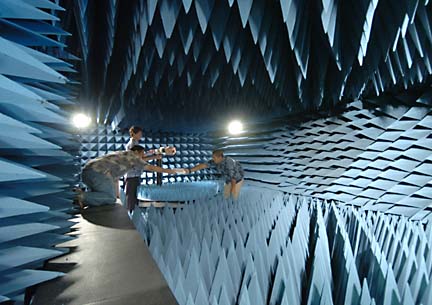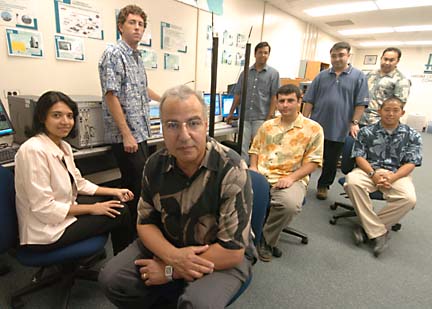
|
UH’s wireless connection
Magdy Iskander brings telecommunications
expertise in helping a research center grow
In three years, Magdy F. Iskander has developed a center at the University of Hawaii-Manoa that is becoming a leader in wireless communications.
"We have in a very short period established research credibility," said Iskander, a professor of electrical engineering who left a distinguished career at the University of Utah to join UH three years ago.
He has attracted $3 million of hard-to-get research money, established a unique antenna lab, had nine published research articles and is working with industries, schools, state and national agencies to produce the "next-generation entrepreneurs in telecommunications."
Iskander established a unique indoor antenna range last July for digital signal processing and design and optimization of next-generation wireless communication systems. "It is the envy of other universities," he said.
Donald Cox, a Stanford University professor of electrical engineering who has been working at the center on sabbatical leave since January, said he's "very impressed" with Iskander's accomplishments in a short time.
"Some things they're doing that we don't do," he said. Stanford doesn't have a lab such as the one at UH, he said: "It is an extremely well equipped wireless communications and antenna lab."
The new College of Engineering unit received some state funding and Iskander began seeking grants and partnerships.

|
He has eight patents, including three since coming here for wireless components or software for Motorola, Raytheon and Kyocera Wireless.
Iskander also is working with the hospitality industry to bring international conferences here to contribute to the state economy.
He was president of the IEEE Antennas and Propagation Society in 2002 and organized a conference here in 2003 on wireless communications. He's planning a similar conference this year and is working up to a major event in 2007.
Iskander had lived in Utah for 25 years and had the only endowed professorial chair at the university. He was comfortable and wasn't thinking of leaving until visiting Hawaii in 2001, he said.
"Walking in Waikiki was just like home (Alexandria, Egypt)." he said. "It attracted me."
He was also drawn to UH, which he said has a "long-standing reputation, a great reputation, in communications." He sees the center as an "incubator for nurturing communications in Hawaii" and is working to strengthen ties between industry and research.
Iskander recognizes it's a small program, with one faculty position and seven students working for masters and doctorate degrees.
So he joined with other universities through the National Science Foundation's Industry University Cooperative Research center to achieve a bigger impact and visibility.
The universities, which meet twice a year to present ideas to an industry board, include Arizona State, the University of Arizona and Rensselaer Polytechnic Institute of New York.
They have a total of 17 corporate sponsors, each paying an annual $50,000 membership fee to support graduate students doing research for the companies. Those supporting UH are Raytheon, Motorola, Kyocera Wireless and Trex Enterprises of Kauai.
Iskander also teamed up with the UH College of Business to support industry and military presence in Hawaii with distance learning. They developed a graduate certificate program in telecommunications and entrepreneurship that began in January with five or six doctoral students on Maui.
Iskander said he also "got a big break" to establish a National Science Foundation Integrative Graduate Education and Research Training Program on "Telecommunications and Entrepreneurship."
NSF committed $3 million, with a matching $1 million from UH, for a program by the engineering and business colleges to prepare next-generation entrepreneurs in telecommunications technology. The two colleges are expected to graduate 20 Ph.D.s in five years.
The NSF also supported the new $1.5 million lab, which Iskander established for undergraduates as "part of our mission to better prepare the workforce."
Students are looking for new ways to improve telecommunications systems in the lab. It's loaded with sophisticated hardware and software to test antenna design and biological effects of cell phones, as well as other systems.
Wayne Kim earned a master's degree at UCLA and decided to work on his doctorate at UH after hearing Iskander was there. "I knew he would be good and things would be happening," Kim said.
Kim is trying to design smaller and less costly antennas for multiple frequency bands that would serve not only communications but global position systems and satellites. He has patents on some designs and is testing new ones in the lab.
Prof helps middle
school get connected
Science students at Kawananakoa Middle School have moved into the wireless communications age with a boost from a University of Hawaii professor.
"We're almost at the cutting edge of providing students with the kind of skills (needed in the future)," said Judith Inouye, an eighth-grade science teacher. "All information is going to be sent wirelessly from one location to another."
Inouye and seventh-grade science teacher Aric Oumi have been developing a wireless curriculum with a $20,000 National Science Foundation grant from Magdy Iskander, director of the Hawaii Center for Advanced Communications in the College of Engineering.
Iskander dipped into his center's money to supply the students with "wireless toys" -- 10 laptops and 12 pocket personal digital assistants.
Iskander wants "to get kids interested in staying here and helping local industry," so he started an outreach program with schools.
New programs will be established at Dole Middle School on Oahu and Keaau Middle School on the Big Island, but he has to match National Science Foundation money "to buy more wireless toys," he said. He sent doctoral student Jodie Bell and master's degree students William Hui and Chad Takahashi to Kawananakoa to set up a wireless network and teach teachers and students how to use it.
"The majority seemed really into it, wanting to learn about it," said Takahashi. "Some definitely are on the ball."
Takahashi went on a Big Island field trip with the eighth-graders in December, helping them use their new devices to record information on lava flows.
"It helps to learn better because of it," said eighth-grader Andie Kida. "It records all the information and we can transfer all the data from one (PDA) to another.
Oumi said the students measured protrusions of lava flows, inputted the information on a grid in the PDA and transferred it from one PDA to another: "Eventually, in the end, we had one PDA which had the whole group's data."
Oumi said all six science teachers in the department worked together to learn how to use the handheld PDAs, which have computing and many other capabilities.
"It made it really exciting for us. We were free to develop our own ideas," Inouye said.
They are developing curriculum lessons not only for field trips but for data analysis, she said: "When we take kids out in the field, we kind of like to emphasize the real science of collecting data."
Oumi said students who went to the Big Island transmitted data they collected to their Web site, so when they got back to school they could retrieve them.
They were able to go to wireless laptops at their desks and find the Web site with the lava flow data, Inouye said: "It became a very meaningful lesson.
"We're not reaching everyone, but because of instruments like this, they can have their own virtual field trip."
E-mail to City Desk
[News] [Business] [Features] [Sports] [Editorial] [Do It Electric!]
[Classified Ads] [Search] [Subscribe] [Info] [Letter to Editor]
[Feedback]
